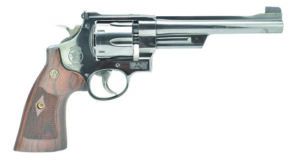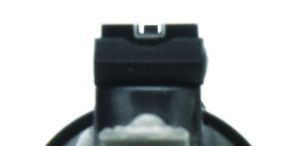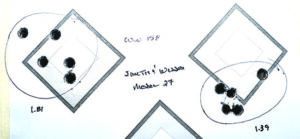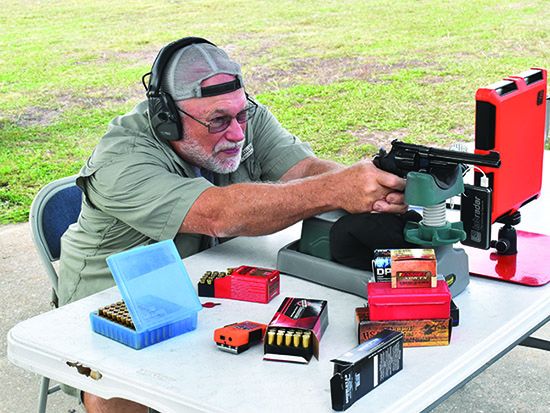Considering our readers’ interest in the 10mm cartridge in recent years, we weren’t too surprised to receive a request to cover the 41 Remington Magnum. With a tad more energy than the 10mm, the 41 Magnum essentially occupies the same space in the energy rankings as its 40-bore brother, but it does so in a rimmed case more suitable for a revolver. But while the 10mm has recovered from its “can’t get no respect” status, the 41 Magnum still suffers from mediocre sales, and we’re not sure why.
Perhaps one of the reasons for the lackadaisical sales is the dearth of firearms chambered in a true .410-diameter bullet. As of this writing, Smith & Wesson is the only company that still catalogs revolvers chambered in 41 Magnum. But that’s OK — they invented the chambering, and they know more than a little about it. In fact, Smith & Wesson invented all three of the earliest magnum chamberings and a new class of revolvers to go with them.
We decided to visit with the latest version of these classic cartridges. Wanting to stay true to the early magnum-capable platforms, we secured three S&W “N” Frame revolvers chambered in 357 Magnum (Model 27), 44 Magnum (Model 29), and 41 Magnum (Model 57). All three of our test guns have 6-inch (or longer) barrels. All three have good, adjustable sights. All three are heavy enough to dampen recoil from the magnum cartridges. All three have top straps that have been tapped and drilled for a scope mount. But could they shoot well enough to earn the moniker of a hunting handgun? We had to find out.
Our first test piece was the 357 Magnum Model 27-9 with the 6.5-inch barrel, Model No. 150341, $1189. Our 44 Magnum Model 29-10 sample was also a 6.5-inch barrel model, and it included a wood presentation case in Model No. 150145, $1309. Then, of course, we looked at the revolver that started this quest, a Model 57-6 chambered in 41 Magnum Model No. 150481, $979. Here’s how they performed at the range.
Smith & Wesson Model 27-9 No. 150341A 357 Magnum
$1189
GUN TESTS GRADE: A-
The long, thin barrel balanced well and handled easily. Our only real gripe is the coarse trigger.

| Action Type | Revolver |
| Overall Length | 12.1 in. |
| Overall Height | 6.25 in. |
| Maximum Width | 1.712 in. |
| Weight Unloaded | 2.96 lbs. |
| Weight Loaded | 3.19 lbs. |
| Receiver Material | Blued carbon steel |
| Front Strap Height | 2.6 in. |
| Back Strap Height | 4.9 in. |
| Barrel Length | 6.5 in. |
| Grip Thickness Maximum | 1.436 in. |
| Grip Circumference | 5.25 in. |
| Rear Sight | Adjustable white outline |
| Front Sight | Black Patridge |
| Sight Radius | 7.8 in. |
| Trigger Pull Weight Single Action | 4.5 lbs. |
| Trigger Pull Weight Double Action | 11.5 lbs. |
| Trigger Span | 3.25 in. |
| Safety | Manual lock |
| Warranty | Lifetime service policy |
| Telephone | (800) 331-0852 |
| Website | Smith-Wesson.com |
| Made In | USA |
Let’s take the way-back machine to the early 1930s. The National Firearms Act of 1934 hasn’t been passed yet, and Tommy guns are available for purchase by the public. Life is good. Except that the country is in the middle of the Depression. And, oh yeah, there are gangsters running around killing people while using better firepower than the police have.
Police in those days were commonly armed with 38 Special revolvers. Sufficient for everyday purposes, those wheelguns left the officers at a serious disadvantage when facing a well-equipped criminal. Colt and Smith & Wesson both decided to help out law enforcement by increasing the power of their ammunition. By using the same technique of making bullets in existing cartridges go faster, both Colt and S&W developed what might well be called +P+ ammunition today. For Colt, it was hot-rodding the 38 Colt cartridge into what we now call the 38 Super. Originally called the Super 38, it could propel a 130-grain FMJ bullet at more than 1200 fps out of their 1911 platform, rather than the sub-900 fps capability of the original. Smith & Wesson called their new round the 38/44 and increased the power level of their 38 Special to more than 1100 fps with a 158-grain bullet. Bad guys were no longer safe simply hiding behind a car door.

Increasing the power factor of a cartridge without changing the platform could easily be a recipe for disaster, so both companies modified their pistols. Metallurgy improved and, many times, the amount of metal in the handgun increased. Barrels, forcing cones and, especially, cylinders grew thicker. Smith & Wesson called their new revolver the 38/44 Heavy Duty or Outdoorsman. Introduced in 1930, it furthered their quest for more power.

The next step in the evolution of the handgun took place in 1935, and, this time, a totally new cartridge resulted. Naming it the 357 Magnum (thus referencing the true diameter of the bullet), Smith & Wesson lengthened the case by just over an eighth of an inch and strengthened it to operate at double the pressure. Ammo that once topped out at about 800 fps with a 158-grain bullet could now generate more than 1300 fps out of a 4-inch barrel. The new cartridge was housed in one of the finest revolvers ever produced the Registered Magnums. The original 357 Magnum handguns were most commonly barreled with 5-inch tubes, though barrels from 4 to 6 inches were available.
Fast forward to 1957 when S&W assumed the current practice of assigning model numbers for their wheelguns. The Registered Magnum became the Model 27. Various improvements were noted by assigning Dash Numbers to the model, such as 27-2 or 27-6. Through 1979, the early dash models still sported pinned barrels, recessed cylinders, and a bluing job deep enough to swim in. Alas, costs for hand-fitting their product skyrocketed while machining improved dramatically. Production methods changed accordingly. Our current production Model 27 is a Dash 9. Gone are the pinned barrel and recessed chamber mouths, but we wanted to see what else changed and how well the latest 27-9 would shoot.
First, a quick primer on S&W revolvers. They come in five frame sizes, including the “J” Frame (think snubnose 38 Special), the “K” Frame (a medium size that is by far the most popular), the “L” Frame (assorted chamberings in the 686 and other lines), the “N” Frame (the larger platform developed for the 38/44), and the “X” Frame (used for the 460 Magnum and 500 Magnums).
The N Frame Model 27 is substantially larger than the K Frame 357. Our test group has a Model 13 in our collection. The M13 is a heavy-barrel fixed-sight 4-inch revolver, also in 357 Magnum, and we used it to make all direct comparisons. Even with the thinner barrel (0.623 inch versus 0.772 inch for the Model 13), the Model 27 weighed almost a half-pound more than the Model 13 at 2.96 pounds. The 27’s cylinder width is larger at 1.713 inches versus 1.448 inches for the M13. Perhaps the most telling indication of extra strength engineered into the N Frame is the width of the chambers at its narrowest point — 0.134 inch versus 0.080 inch for the K Frame. Our M27 did give up some weight to the Model 13 on the barrel, with the grooves only measuring 0.134 inch versus 0.207 inch on the smaller revolver. Surprisingly, our Model 27 had a cylinder that was shorter overall (1.574 inch) than two K frames we measured (1.679 inches and 1.627 inches). It would appear that S&W was trying to keep this large-framed 357 Magnum as svelte and well-balanced as possible.
Just because it was thin didn’t mean we didn’t like the barrel. Heavy just in front of the frame, it slims down quickly for the rest of its 6.5-inch length ending in a tall Patridge-type black-only front sight. Together with the white outline rear, it provided an excellent sight picture and fine balance. The front sight is also pinned, allowing you to change it out if so desired. The top surface of the barrel is actually checkered, not just grooved, to reduce glare, ending in a ramp that leads up to the front sight. Even the top strap is checkered. The top strap is also drilled and tapped for a scope mount. With the longer barrel and resultant velocity, this Model 27 and a good scope might make an outstanding small-game hunting rig.
The Model 27 in 357 Magnum was fun to shoot — at least until we started running the Doubletap 200-grain ammo. Those loads were pushing 44 Magnum territory. Still, we liked the balance of the heavy pistol when shooting the top-range loads. Take a look at the velocities in the Range Data table and see the quickness that revolver produced.
If you look at the photos, you’ll also note how the heavy trigger made us put our finger in to the distal joint, pulling the shots to the right. Our bad, but a smoother trigger would help. Don’t worry, Smith & Wesson triggers lend themselves to the ministrations of a good pistolsmith. The speed exercises showed a reduction of 16% versus the Model 57, which was 27% less than the Model 29. The Model 27 also had the best time to first shot because, we think, our eyes were able to pick out that tall Patridge sight quickly.
Our Team Said: The team liked the Model 27’s balance, its easy-to-shoot nature with most loads, its speed on the combat range, its fit and finish, and its ability to scale up power. We would probably buy this one and get a good trigger job, then be happy for a long time.
| 357 Magnum, 41 Magnum, and 44 Magnum Range Data | |||
| Smith & Wesson Cor-Bon DPX Model 27 357 Magnum | Cor-Bon DPX 125-grain JHP | Winchester 158-grain JSP | Doubletap 200-grain Hardcast |
| Average Velocity | 1236 fps | 1154 fps | 1284 fps |
| Muzzle Energy | 424 ft.-lbs. | 467 ft.-lbs. | 733 ft.-lbs. |
| Average Group Size | 1.75 in. | 1.67 in. | 1.93 in. |
| Best Group Size | 1.47 in. | 1.39 in. | 1.71 in. |
| Smith & Wesson Model 57 41 Magnum | Barnes 180-grain Vortex | HSM 210-grain SWC | Remington 210-grain JSP |
| Average Velocity | 1381 fps | 904 fps | 1294 fps |
| Muzzle Energy | 762 ft.-lbs. | 381 lbs. | 781 ft.-lbs. |
| Average Group Size | 2.31 in. | 1.69 in. | 1.83 in. |
| Best Group Size | 1.65 in. | 1.51 in. | 1.63 in. |
| Smith & Wesson Model 29 44 Magnum | Hornady 200-grain Flex | Black Hills 240-grain JHP | Doubletap 320-grain Hardcast |
| Average Velocity | 1407 fps | 1247 fps | 1343 fps |
| Muzzle Energy | 879 ft.-lbs. | 829 ft.-lbs. | 1282 ft.-lbs. |
| Average Group Size | 2.77 in. | 1.71 in. | 3.45 in. |
| Best Group Size | 1.83 in. | 1.47 in. | 2.35 in. |
All shooting was done at American Shooting Centers (AmericanShootingCenters.com) in Houston. Accuracy was tested at 15 yards by shooting multiple five-shot groups from a well-sandbagged Caldwell Pistolero shooting rest (MidwayUSA.com 517357, $2) assisted by a Mini DRC Fortune Cookie from Wiebad.com ($75, MINIFC). We chose a variety of ammo types and weights for each cartridge by using the Ammoseek.com search feature. In 357 Magnum, we found Cor-bon DPX 125-grain solid-copper bullets, Winchester SuperX 158-grain JSPs, and Doubletap 200-grain hard cast rounds. The 41 Remington Magnum selection included Barnes VOR-TX 180-grain XPB cartridges, HSM 210-grain Cowboy Loads, and Remington’s 210-grain XTP hollow point. The 44 Remington Magnum fodder also covered the weight and power spectrum with Hornady 200-grain MFX, Black Hills 240-grain JHP, and Doubletap 320-grain hard-cast bullets.
| DRILL DATA | |||
| Pistol | 1st Shot | Split Average | Total Time |
| Model 27 | 0.933 | 0.382 | 1.697 |
| Model 29 | 1.217 | 0.772 | 2.760 |
| Model 57 | 1.08 | 0.468 | 2.017 |
Process: Fire three shots from low ready at a USPSA target at 8 yards. Numbers are averages for three repetitions. Times are in seconds.
Written and photographed by Joe Woolley, using evaluations from Gun Tests Team members. GT





























Very good article, timely and relevant to those interested in big bore revolvers. The author did slip a bit by claiming S&W was the lone producer of .41 Mag revolvers. Ruger might have something to say about that! Thanks for a great article.
I have on of the original Model 27 S&W revolvers. You can’t beat a classic. I also have a 6″ barreled S&W Model 657 in .41 Remington Magnum as well as a S&W Model 58 (also in .41 Remington Magnum).
The older revolvers just have more “cachet” than S&W’s newer offerings.